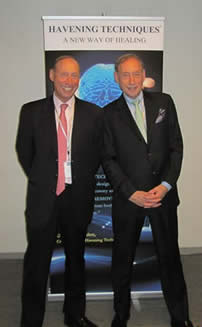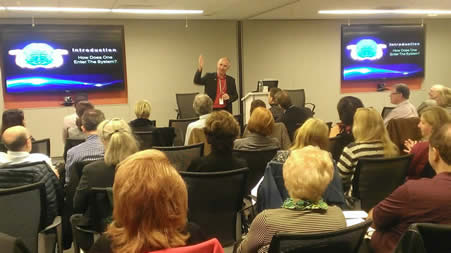Havening Techniques have been developed by Dr Ron Ruden, MD in collaboration with his brother Dr Steven Ruden who are based in New York running private medical and dental practices respectively. Dr Ron Ruden has been studying neuroscience for 20+ years in order to develop science-based methods and techniques to help his own clients. For more than 10 of those years his focus has been on designing, researching, clinically testing and evolving a really effective set of approaches for quickly, thoroughly and reliably treating trauma and other amygdala-based issues (basically anything involving fight or flight responses). The result of this ground-breaking work is Havening Techniques. Now these methods are being taught to therapists, medics, coaches and many others in caring professions and people-development professions across the world. Havening work is being done with military veterans, members of the public, students, sports people, performers … and this work is positively touching the lives of people from all walks of life.
Now you too can learn Havening Techniques.
Above: Dr Ron Ruden (originator of Havening Techniques)
Photo taken when I visited him at his office in 2014.
One of the many wonderful things about Havening is how it can be integrated into a wide range of existing therapeutic practices.
It can also be used within coaching work, personal development programmes and interventions focused on achieving and maintaining peak performance.
Above: Dr Steven Ruden (left) and Dr Ron Ruden (right) – originators of Havening Techniques
In terms of therapeutic applications of Havening Techniques, the methods work by permanently stopping the neurons that hold the biological imprint of trauma from being able to trigger unhelpful responses.
The way it works is deceptively simple, powerful and pure genius!
And although simple, training in the whole range of Havening Techniques and gaining experience in the plethora of ways the techniques can be used and combined is going to be crucial if you are to be most flexible and elegant in your change-work.
Havening uses the sensory input of touch as a key part of its effectiveness. The practitioner (or the clients themselves) makes particular sweeps over the client’s arms and areas of the face and hands. This is what triggers the delta waves in the brain. The delta waves in turn prompt helpful chemical chain-reactions in the amygdala. This removes specific AMPA Receptors from the surface of neurons in the amygdala where the traumatic event is ‘stored’. For some particular uses of Havening there are also some distraction techniques used so that as the work is being done, the area of the brain storing the trauma is not constantly being re-activated.
Traumatic experiences can lead to the brain encoding the experience in ways that can lead to psychological and / or physical ‘symptoms’. Havening can help to treat all of these symptoms.
Examples of therapeutic areas where Havening has been put to good use, include:
• Treating Phobias
• Treating Chronic Pain
• Removing the emotional responses to distressing memories (broken relationships, shocking news, loss, embarassment, etc)
• Treating emotional responses resulting from experiences of natural disaster, traumatic events (assault, rape, abuse, crime etc) and also experiences of war.
• Removing anger responses
• Removing fear of abandonment
• Helping people release grief
• Helping people remove unhelpful feelings: stress, frustration, upset etc
• Treating Post Traumatic Stress Disorder (PTSD)
• Treating panic attacks
… and more!
Above: Tony Burgess teaching Havening Techniques in New York
Above: Tony Burgess delivering Havening Techniques training in Manchester, UK
And for those of you involved in coaching, personal development work or performance enhancement work in business or sport …
Havening can be used to help people to more effectively work with affirmations and positive visualisations. It can help people with state management (eg for meetings, presenting, networking). It can help people get out of their own way and also embed positive beliefs and attitudes. You can use Havening to help people to increase their confidence and to help prime their minds for greater performance. It’s as if the Delta-wave production resulting from Havening Techniques provides a nourishing biological seedbed for positive ideas to take root.
Havening Techniques combine easily and elegantly with many other methods and approaches. They will integrate into your existing toolbox perfectly.
Havening Techniques complement rather than compete with other methods.
Experience has shown us that Havening tends to enhance the effectiveness of other methods when used in combination with them. It also seems to accelerate the process of getting results and seems to increase the consistency of results too.
Tony Burgess and Julie French are certified practitioners of Havening Techniques. Havening Techniques is a registered trademark of Ronald Ruden, 15 East 91st Street, New York. www.havening.org




